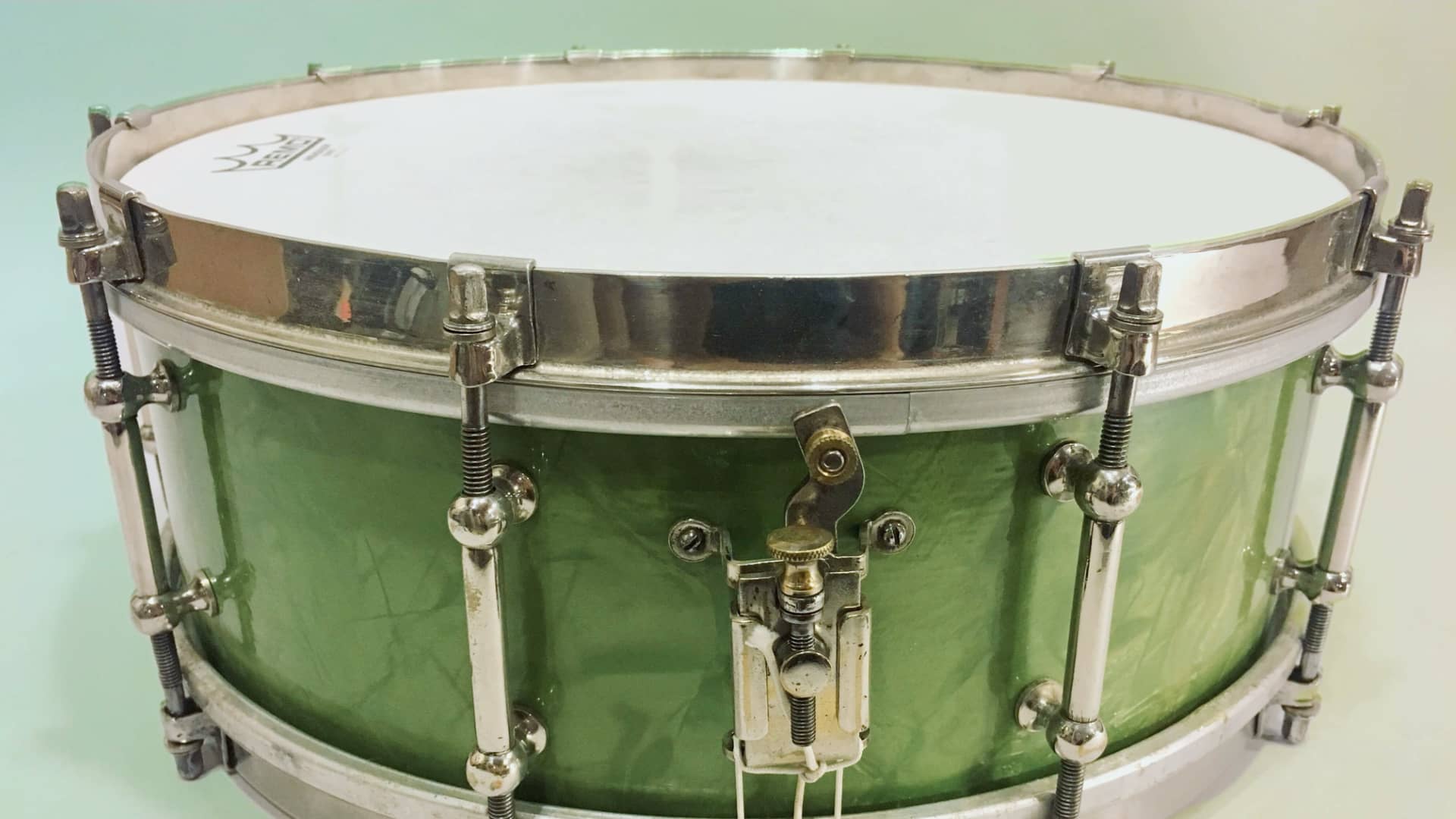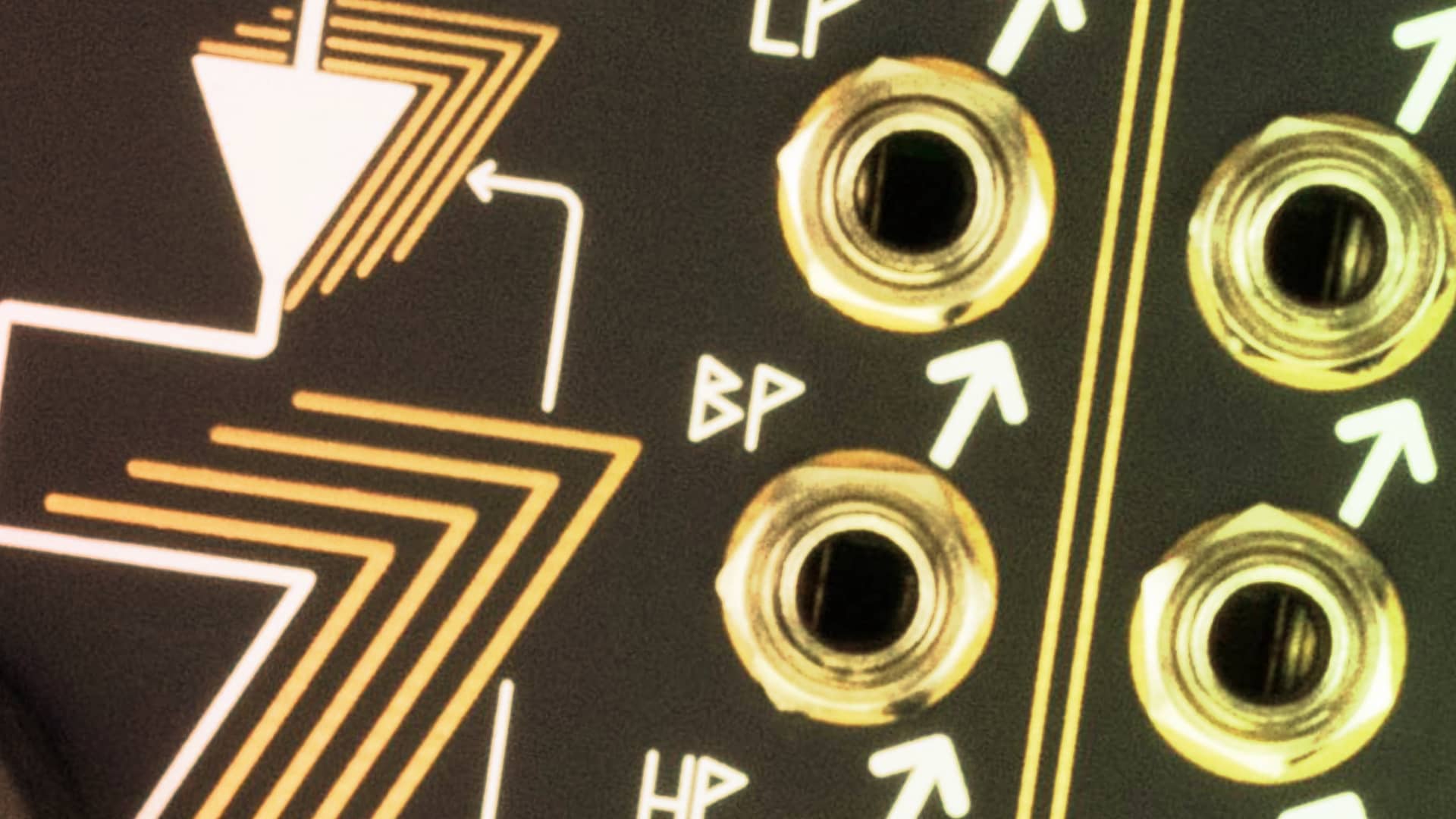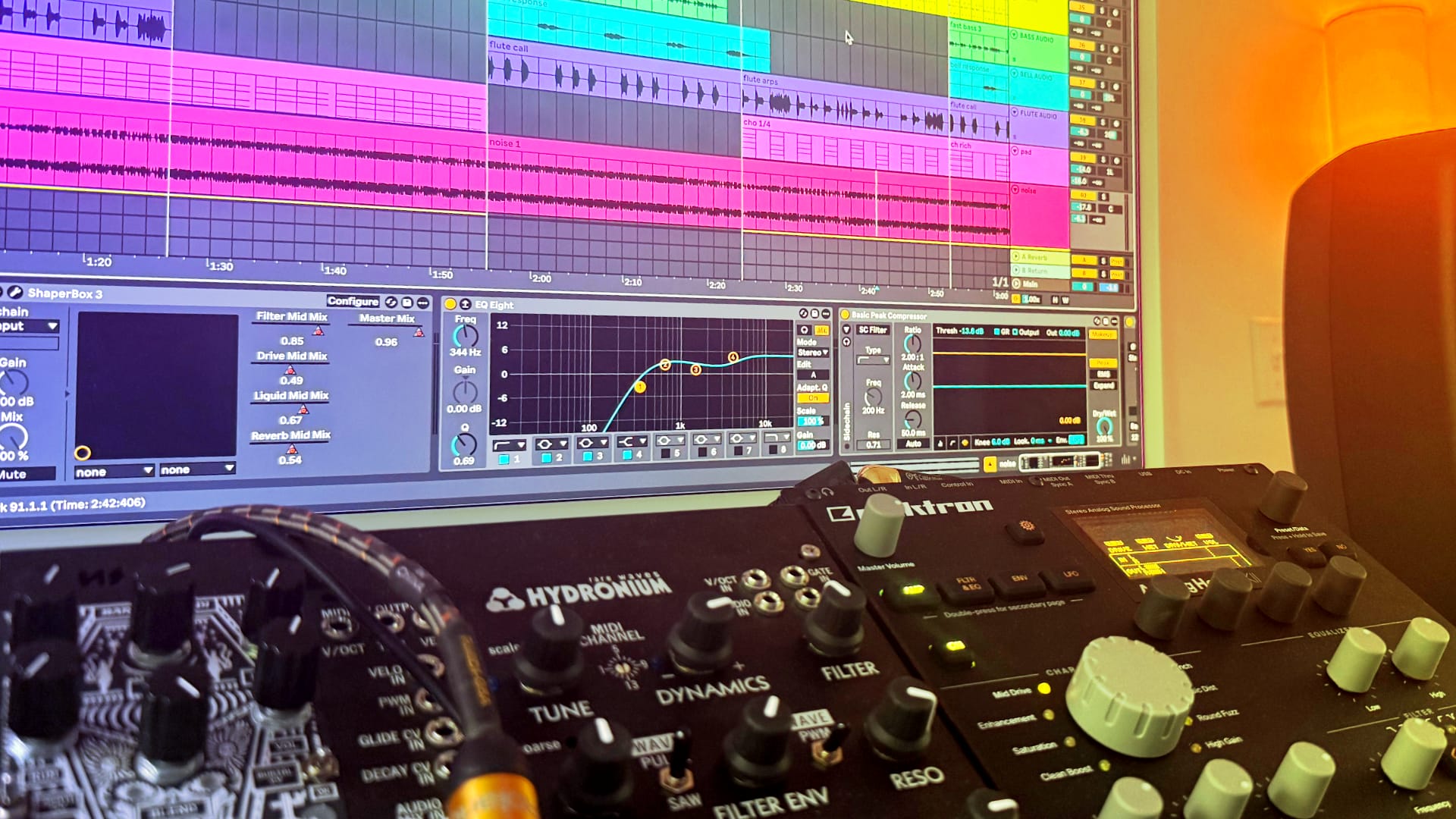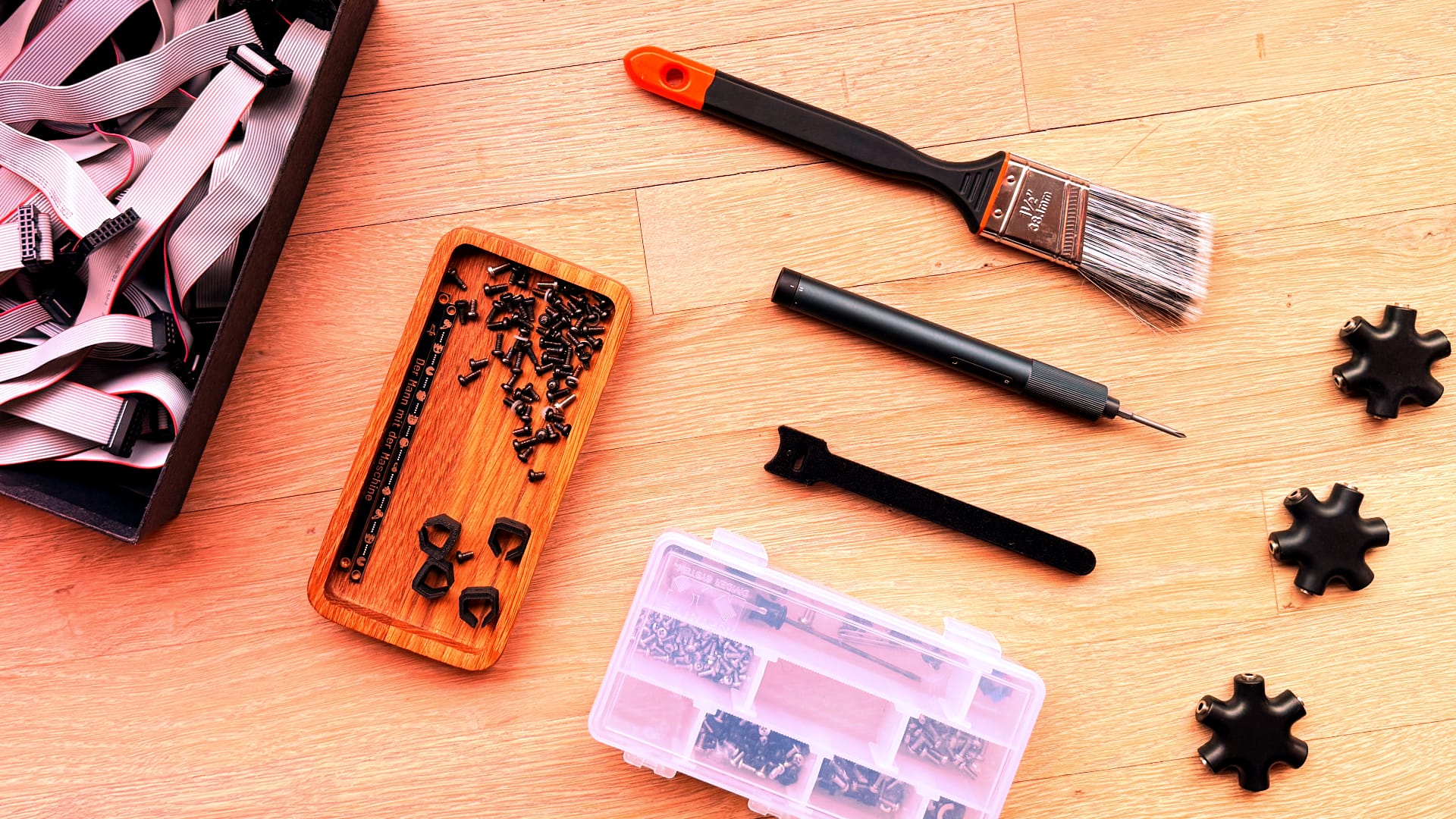A few days ago, I was scrolling through YouTube and stumbled upon a video titled kind of like, “Synthesize Real Snare Sounds using the Power of Feedback.” Naturally, I was curious. But as I watched, it became clear that the approach was way more complicated than necessary. Plus, there was a fair bit of misinformation driven by a lack of understanding. While I resisted the urge to jump into the comments and play Patch Police, it did inspire me to write this article.
Translating sound design from software and a DAW to hardware isn’t always straightforward. I found myself pausing and rewinding the video to follow the signal flow. Early on, the creator mentioned using a “plain delay—not one with fancy panning or feedback.” This was confusing since “feedback” was in the video title. A bit more watching, and I realized he was unknowingly using Karplus-Strong synthesis to create the body and ring of the snare. He made a transient, used it as an impulse for a delay line, and manually fed it back into the signal. Honestly, a “fancy delay” with built-in feedback would’ve saved some time. That said, using Karplus-Strong synthesis was an interesting approach. I broke down the signal flow, simplified it, and applied it to some basic modules.
Why Not Just Use Samples?
Sure, you can. Samples are great and a quicker way to get to the end result. But unless you’re using multi-samples, getting variance across different parts of the sound to make the snare feel more “real” is tricky. Plus, it’s just plain fun to synthesize your own sounds and make them truly unique. While it’s easy to create electronic snares with sharp transients and synthetic noise, getting a snare that captures the subtle nuances of an acoustic drum is a whole different beast. But with the right techniques and modules, you can craft snares that feel lifelike, adding depth and character to your beats.
What Makes a Snare Sound Like a Snare?
For this article, I’m focusing on the parts of the snare that are relevant to designing snare sounds. This won’t be an exhaustive breakdown of snare anatomy, but we’ll dig deeper than just the basics.
- Batter Head: The top snare head you hit with your drumstick.
- Tension Rods: Attached to the counterhoops (the rim), these rods hold the batter and resonant heads. Changing the tension alters the overall pitch.
- Shell: The cylindrical body of the drum that holds everything together and creates an air chamber for the sound to resonate within.
- Resonant Head: The bottom drum head that resonates sympathetically when the batter head is struck.
- Snare Wires: The spring-like wires on the bottom of the drum that vibrate when in contact with the resonant head, adding that noisy, snappy character.
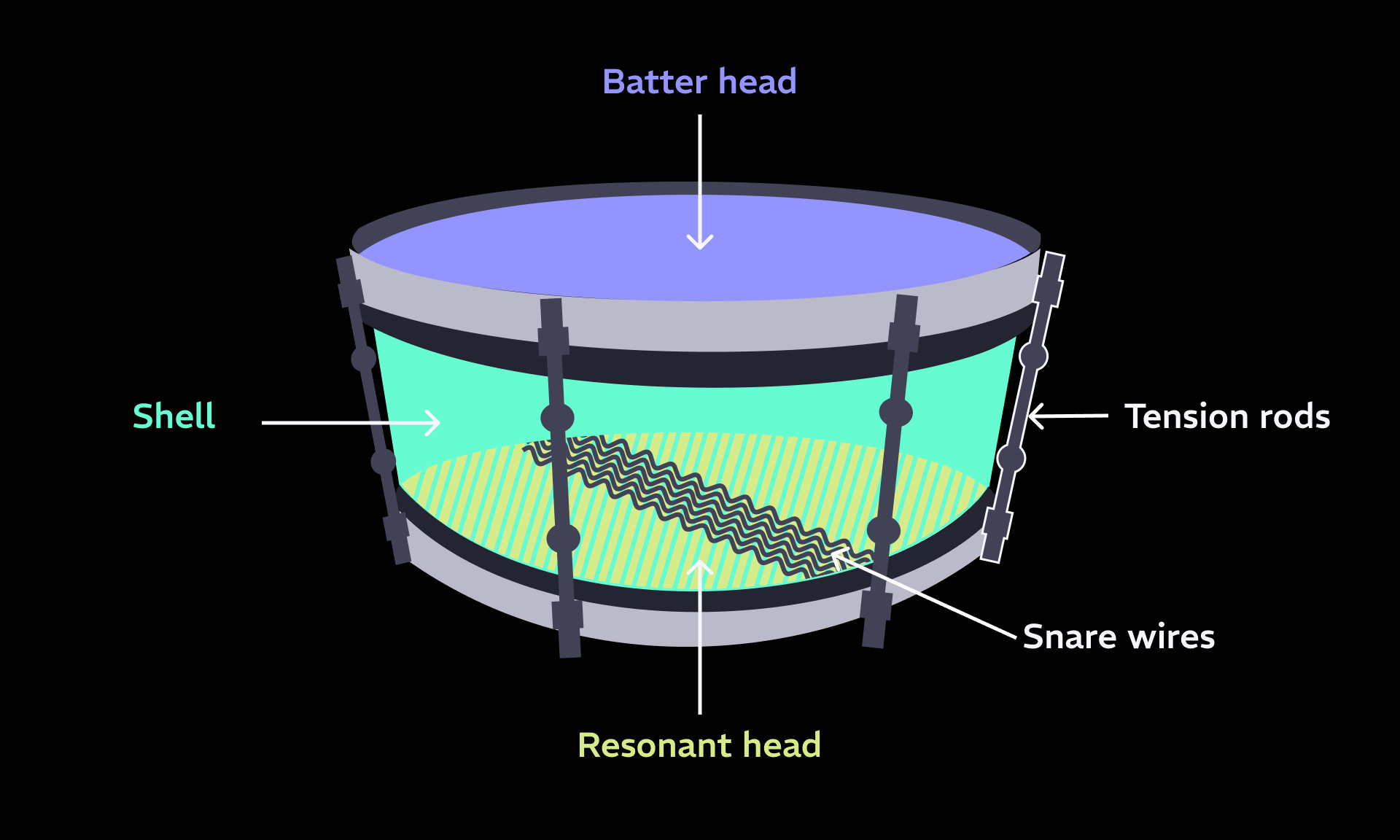
Now that we’ve defined the parts, let’s look at how they work together to create sound. Imagine the physics when hitting a snare: a stick swings with force, collides with the batter head, and sets off a chain reaction that we can break down in the time domain:
- Transient: The first 1-6 milliseconds—the initial crack of the drumstick hitting the batter head.
- Body: Overlaps with the transient and defines its weight.
- Ring: Shortly after the transient, the resonant head vibrates with the batter head, creating a pitched sound that decays naturally.
- Noise: The higher frequency snare wires start vibrating from direct contact with the resonant head.
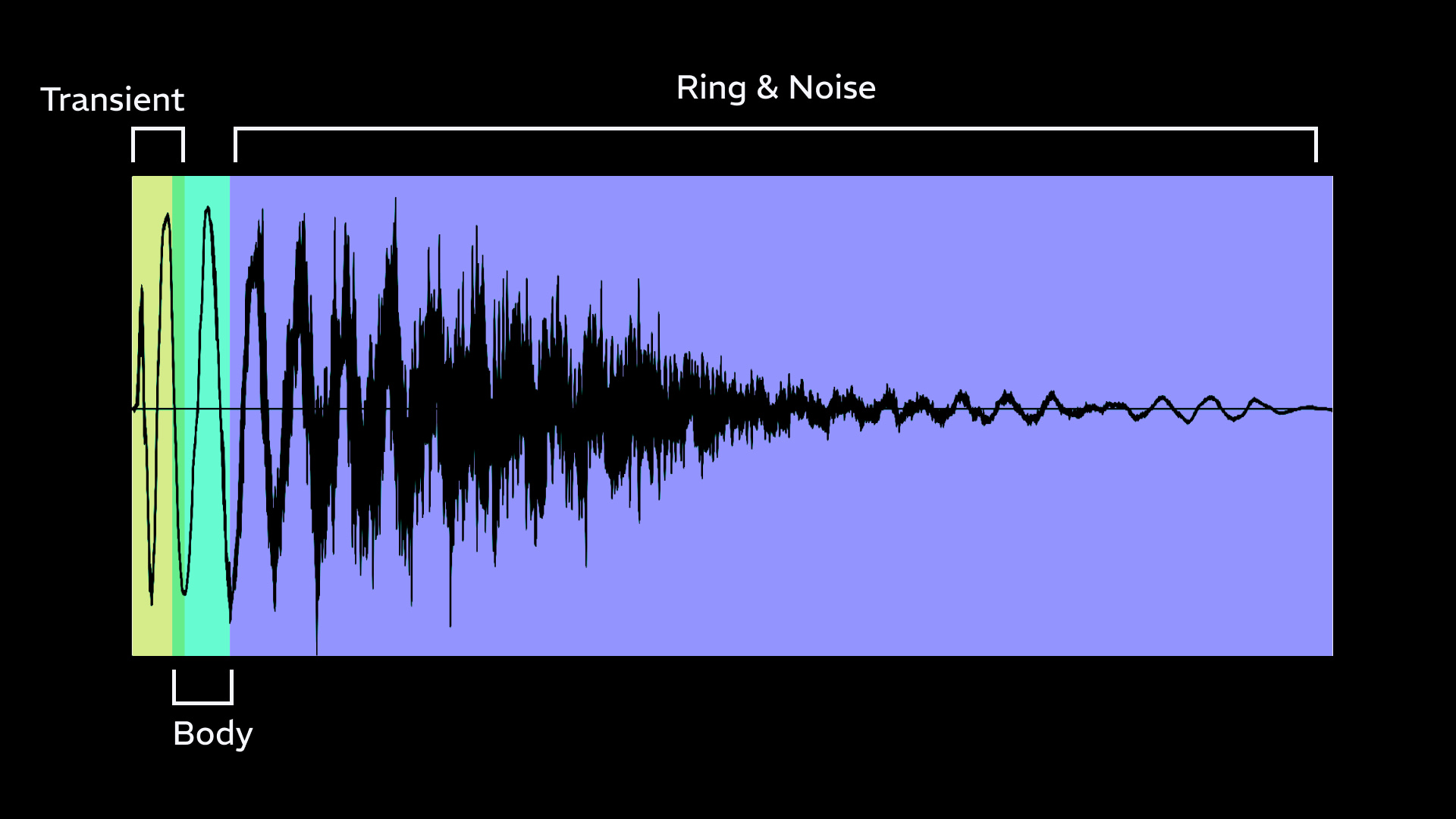
Of course, there are plenty of nuances that can alter the sound, like how hard you hit or where you hit the batter head. A stronger hit makes the sound louder, brighter, and with a longer ring. Hitting closer to the edge of the drum raises the pitch because the tension is higher and there’s less oscillation. When you think about how a drummer might vary their hits, you start to see the large amount of variance within a small range. Yet most folks use the same sample, at the same volume, with zero dynamic change. The human ear gets tired of this repetition quickly, so adding some nuance will get you closer to an acoustic drum sound.
Patches
I spent some time experimenting with the various elements—transient, body, ring, and noise. Below are several snare patches. They share similarities but each has its own unique vibe, perfect for creating more acoustic-sounding snares in a modular setup. Let’s dive into some specific patches to achieve these acoustic snare sounds.
Karplus-Strong Snare
This is my take on the patch I saw in the video. It creates a pretty convincing acoustic snare, and tweaking a few parameters gives you a nearly infinite range of different snare sounds. One key things to note is the HPF into the LPF, this really shapes the sound and makes the ring sound like a snare ring. Carve off the top and bottom to taste.
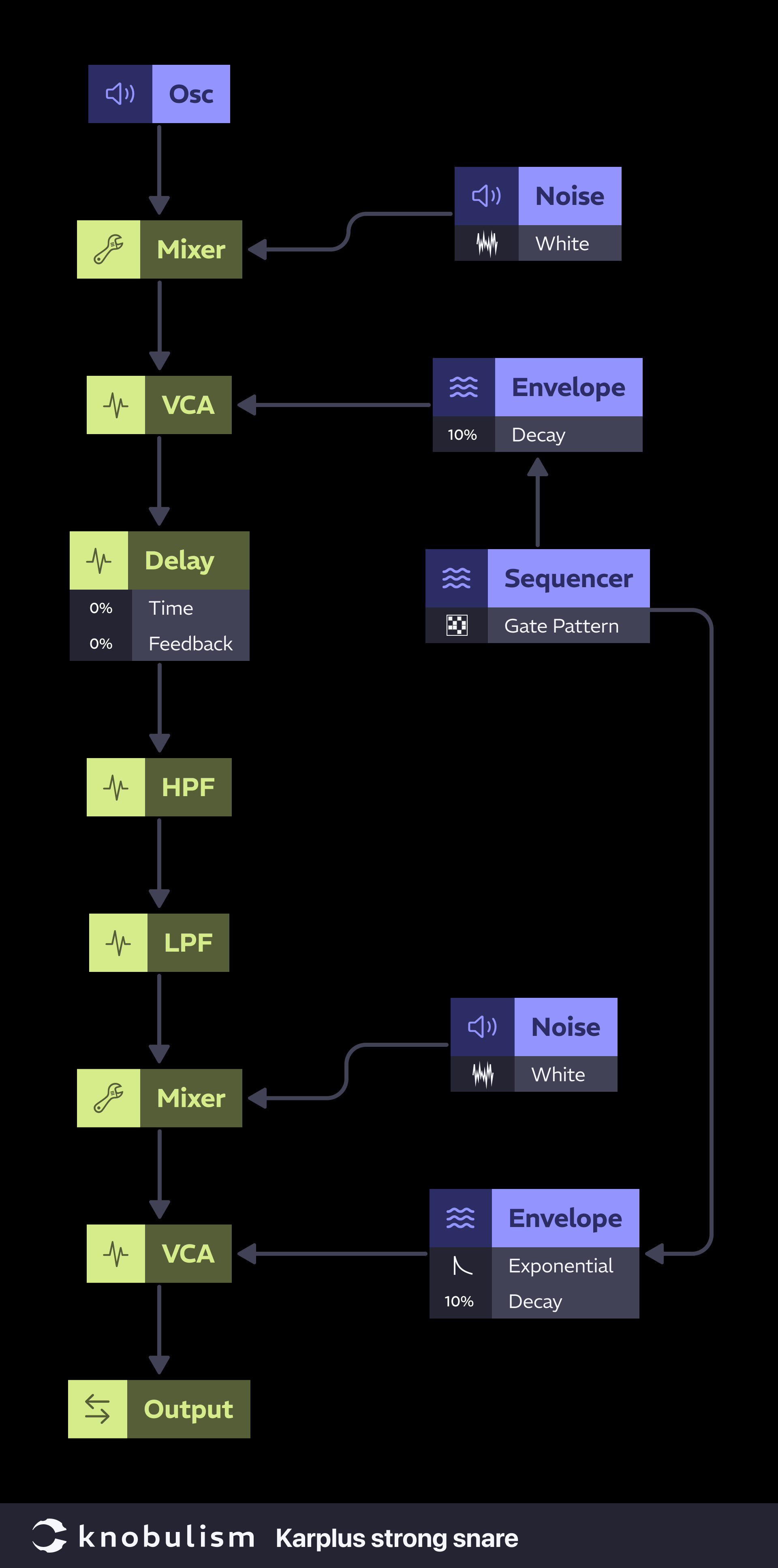
After patching the Karplus snare, I remembered the guy in the video mentioning how this approach is different from traditional drum machine sounds. But actually, this method is almost exactly like most snare sound design methods—only the way the ring is created changes. So, I tried other methods to create ringing resonance, and they worked too.
FM Snare with Volume Dynamics
The body of the snare in this patch is FM generated. Set the pitch relationship to taste, but I suggest atonal. Also in this patch I add some level dynamics for extra realism.
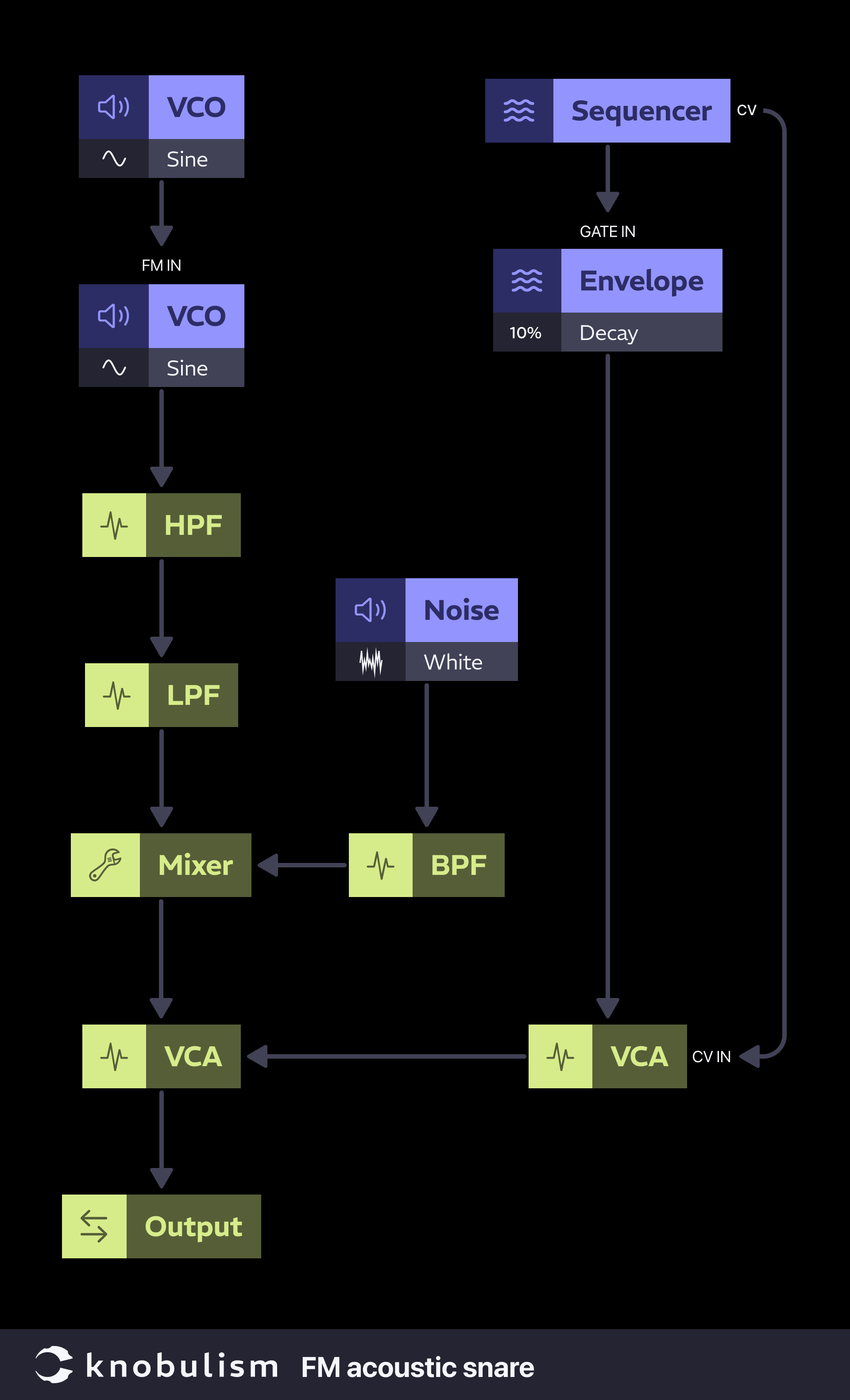
Frequency Shifter Snare
Continuing with alternate methods of creating snare ring, I thought a frequency shifter might be really interesting. Going further than just level dynamics I add CV to the band pass filter so when the snare is “hit harder” it sounds a bit snappier.

Additive Snare
Still thinking about ring and harmonics I wondered what using additive synthesis might yield. The result might be the best yet. I also add another level of dynamics by sending a copy of the dynamic level envelope to the pitch of the osc, creating a dynamic pitch sweep.
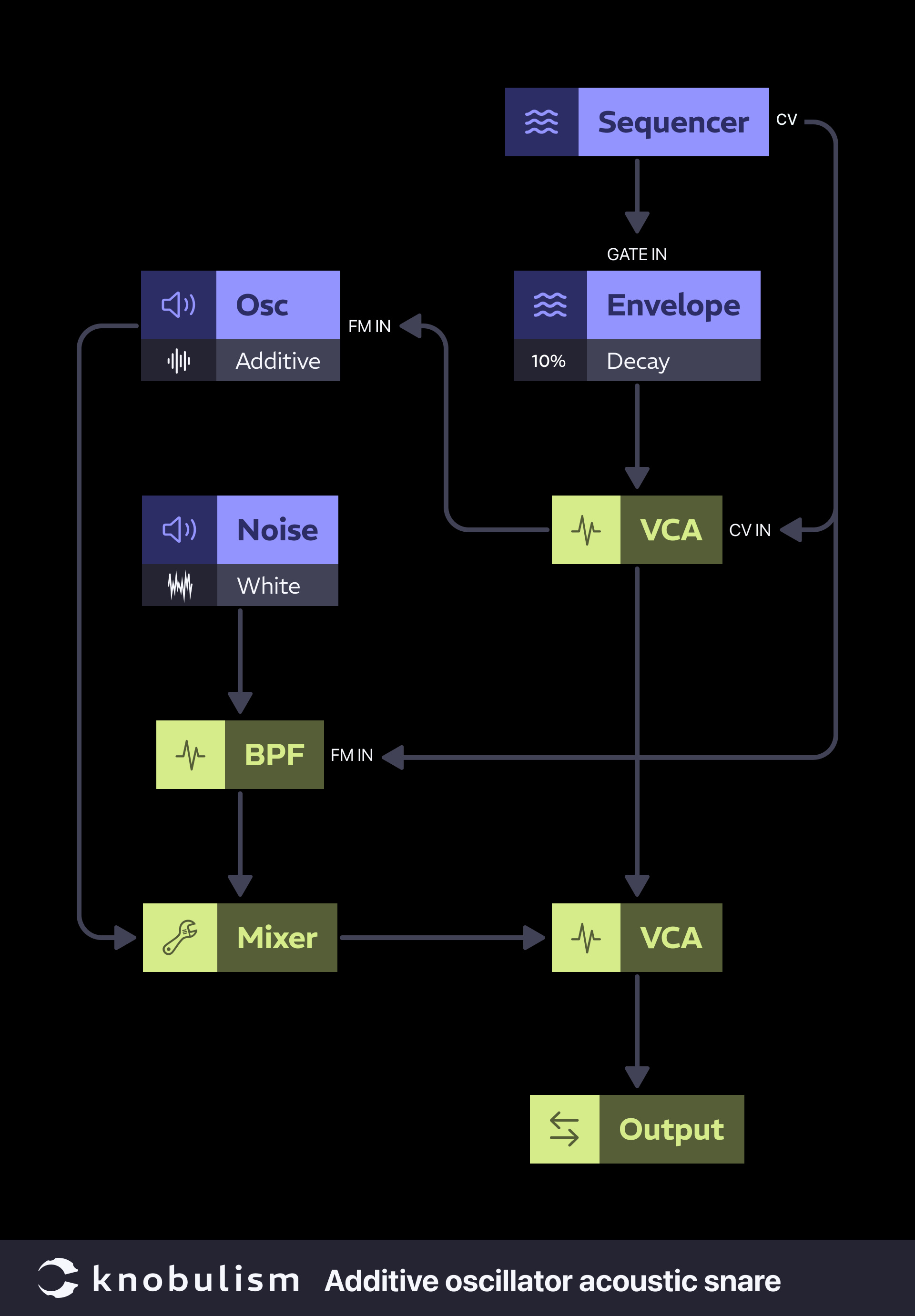
Want to Make Acoustic Snares in Less HP?
1. Steady State Fate Ultra-Perc: A fully analog percussion module that can make some snappy, acoustic-sounding snares. It even has twin resonant cores that can be detuned, mimicking the batter and resonant heads on a drum.
2. Modbap Modular Trinity: A digital 3-channel drum synth with multiple sound design algorithms tuned for percussive sounds. You can make three snares or break the snare down into parts and create the transient, body, and ring, mixing all three channels for a super snare.
3. WMD Kraken: A physical modeling digital synthesis snare module that has probably the most convincing acoustic snare sounds I’ve ever heard.
Practical Tips and Insights
- Filtering the ring is key: Get in there with a variable width band-pass or even better a LPF and HPF in series.
- Stepped modulation adds life: Use subtle modulation on pitch, filters, or VCAs to introduce small variations in each snare hit, mimicking the natural inconsistencies of an acoustic drum.
- • Don’t overdo reverb: While reverb adds realism, too much can make the snare lose its punch. Keep it short and tight for the best results.
Creating acoustic-sounding snares in a modular environment is a rewarding challenge that can greatly enhance the realism and character of your music. By carefully selecting and tuning your modules, layering sounds, and applying thoughtful modulation, you can craft snares that stand out and bring a more human element to your tracks. So, get patching and explore the vast potential of your modular synths to produce those rich, organic snare sounds.
Share your thoughts and experiences in the comments below!

